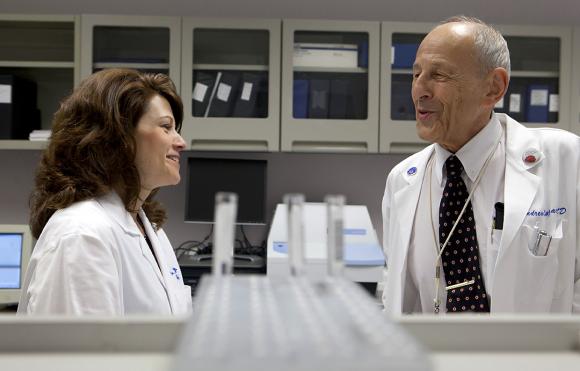PROVIDENCE, R.I. [Brown University] — Given how much patients invest in in vitro fertilization (IVF), both financially and emotionally, tools to inform couples about what they might expect during their treatment can be welcome. A study by researchers at Brown University and Women & Infants Hospital shows that as the IVF cycle is beginning, a blood test for levels of a hormone called AMH, or antimullerian hormone, can help predict the number of eggs that will be harvested.
“Clinicians can measure AMH before or during ovarian stimulation to counsel couples about their likelihood of success,” said Geralyn Lambert-Messerlian, professor of pathology and laboratory medicine in the Warren Alpert Medical School of Brown University and a researcher in the Division of Medical Screening and Special Testing at Women & Infants Hospital. She co-authored a paper that will be published in an upcoming issue of the American Journal of Obstetrics and Gynecology. It appeared in advance online last month.
Lead author Andrew Blazar, a physician at Women & Infants’ Division of Reproductive Endocrinology and Infertility, said the finding could be useful for adjusting IVF preparations on the fly, for instance by adjusting how much follicle stimulation hormone women are receiving in the week or so before eggs are extracted for fertilization.
“The main thrust of the paper is that you can do this test even after you have begun the preparations for initiating an IVF cycle, so it allows you to modify your treatment, at least in theory, so that your probability of success would be improved,” said Blazar, who is also a clinical associate professor of obstetrics and gynecology at the Alpert Medical School. “Though not proven, this approach seems like a logical way to use this new information.
“What I’m hoping is that eventually it will turn out that you can now do this test in the same cycle and not wait until you have to do another cycle, which would be a considerable advantage to your patient,” he said.
The research was partly supported by Beckman Coulter Inc., which makes the assay the team used for measuring AMH in blood samples.
AMH predicts eggs, pregnancy
AMH is made by small follicles in the ovary and helps regulate their growth. AMH levels in the blood are an indicator of how many follicles a woman has at the time of the hormone measurement.
In their research, Blazar and Lambert-Messerlian’s team measured AMH levels in 190 IVF patients, ages 22 to 44, both at the beginning and end of their preparatory course of follicle stimulation hormone treatment. They counted the eggs that were eventually harvested and then performed blood tests and later an ultrasound to confirm pregnancy.
The researchers found that women with low AMH levels in the first test (less than one nanogram per milliliter) on average yielded only about six eggs, while women who had more than three times as much AMH provided about 20 eggs on average.
In this study, AMH similarly predicted whether pregnancy became established. Only about a quarter of women with less than one nanogram of AMH were pregnant five to six weeks after the IVF procedure. Among women with more than three nanograms, three in five were pregnant at that stage.
Lambert-Messerlian cautioned that most other studies have not found an association of AMH levels and pregnancy success though delivery.
Blazar noted that because some women with low AMH levels were still able to establish pregnancies, he wouldn’t recommend that all such women necessarily forgo an upcoming IVF procedure.
In addition to Blazar and Lambert-Messerlian, other authors include Sandra Carson and Jared Robins, both professors at Brown and physicians at Women & Infants, and Stephen Krotz and Richard Hackett, physicians at Women & Infants.

